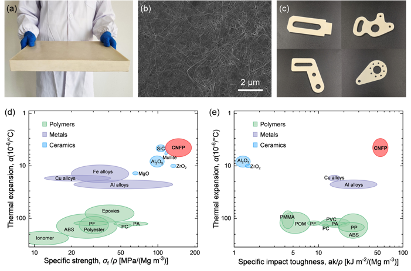Plastic is a kind of widely used artificial material. The invention of plastic gives us a lightweight, strong and inexpensive material to use but also bring us the plastic apocalypse. Many of the unrecycled plastic waste ends up in the ocean, Earth’s last sink. Broken by waves, sunlight and marine animal, a single plastic bag can be broken down into 1.75 million microscopic fragments, which is called microplastics. Those microplastics might finally end up in our blood and system through the fish we eat or the water we drink.
During the long-term evolution of most plants on the earth, cellulose-based materials have been developed as their own structural support materials. Cellulose in plants mainly exists in the form of cellulose nanofibers (CNF), which have excellent mechanical and thermal properties. CNF, which can be derived from plant or produced by bacteria, is one of the most abundant all-green resources on Earth. CNF is an ideal nanoscale building block for constructing macroscopic high-performance materials, as it has higher strength (2 GPa) and modulus (138 GPa) than Kevlar and steel and lower thermal expansion coefficient (0.1 ppm K-1) than silica glass. Based on this bio-based and biodegradable building block, the construction of sustainable and high-performance structural materials will greatly promote the replacement of plastic and help us avoid the plastic apocalypse.

Nowadays, a team lead by Prof. YU Shuhong from the University of Science and Technology of China (USTC) report a high-performance sustainable structural material called cellulose nanofiber plate (CNFP) (Fig. 1a and c) which is constructed from bio-based CNF (Fig. 1b) and ready to replace the plastic in many fields. This CNFP has high specific strength (~198 MPa/(Mg m-3)), which is 4 times higher than that of steel and higher than that of traditional plastic and aluminum alloy. In addition, CNFP has higher specific impact toughness (~67 kJ m-2/(Mg m-3)) than aluminum alloy and only half of its density (1.35 g cm-3).
Unlike plastic or other polymer based material, CNFP exhibit excellent resistance to extreme temperature and thermal shock. The thermal expansion coefficient of CNFP is lower than 5 ppm K-1 from -120 °C to 150 °C, which is close to ceramic materials, much lower than typical polymers and metals. Moreover, after 10 times of rapid thermal shock between 120 °C bake oven and -196 °C liquid nitrogen, CNFP remain its strength. Those result shows its outstanding thermal dimensional stability, which allow CNFP to own great potentials used as structural material under extreme temperature and alternate cooling and heating. Owing to its wide range of raw materials and bio-assisted synthesis process, CNFP is a kind of low-cost material with the cost of only 0.5 $/kg, which is lower than most of plastic. With low density, outstanding strength and toughness, and great thermal dimensional stability, all of those properties of CNFP surpass those of traditional metals, ceramics and polymers (Fig. 1d and e), making it a high-performance and environmental-friendly alternative for engineering requirement, especially for aerospace application.
CNFP not only has the power to replace plastic and saves us from drowning in them, but also has great potential as the next generation of sustainable and lightweight structural material.
Author
GUAN Qingfang
Source
University of Science and Technology of China, press release, 2020-05-01.
Supplier
University of Science and Technology of China (USTC)
Share
Renewable Carbon News – Daily Newsletter
Subscribe to our daily email newsletter – the world's leading newsletter on renewable materials and chemicals










